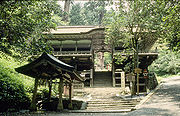
Kurama-dera Cable
Encyclopedia


Funicular
A funicular, also known as an inclined plane or cliff railway, is a cable railway in which a cable attached to a pair of tram-like vehicles on rails moves them up and down a steep slope; the ascending and descending vehicles counterbalance each other.-Operation:The basic principle of funicular...
line operated by Kurama-dera, a famous Buddhist
Buddhism
Buddhism is a religion and philosophy encompassing a variety of traditions, beliefs and practices, largely based on teachings attributed to Siddhartha Gautama, commonly known as the Buddha . The Buddha lived and taught in the northeastern Indian subcontinent some time between the 6th and 4th...
temple in Mount Kurama
Mount Kurama
is a mountain to the north-west of the city of Kyoto. It is the birthplace of the Reiki practice, and is said to be the home of Sōjōbō, King of the Tengu, who taught swordsmanship to Minamoto no Yoshitsune...
, Sakyō
Sakyo-ku, Kyoto
is one of the eleven wards in the city of Kyoto, in Kyoto Prefecture, Japan. It was created in 1929 when it was split off from Kamigyo-ku.It is located in the north-east corner of Kyoto city. In the east it borders the city of Ōtsu in Shiga Prefecture. In the south Sanjō Street separates it from...
, Kyoto
Kyoto
is a city in the central part of the island of Honshū, Japan. It has a population close to 1.5 million. Formerly the imperial capital of Japan, it is now the capital of Kyoto Prefecture, as well as a major part of the Osaka-Kobe-Kyoto metropolitan area.-History:...
, Japan
Japan
Japan is an island nation in East Asia. Located in the Pacific Ocean, it lies to the east of the Sea of Japan, China, North Korea, South Korea and Russia, stretching from the Sea of Okhotsk in the north to the East China Sea and Taiwan in the south...
. The line is officially called .
Basic data
- Distance: 0.2 km
- Vertical interval: 96 m
- GaugeRail gaugeTrack gauge or rail gauge is the distance between the inner sides of the heads of the two load bearing rails that make up a single railway line. Sixty percent of the world's railways use a standard gauge of . Wider gauges are called broad gauge; smaller gauges, narrow gauge. Break-of-gauge refers...
: 800 mm - Stations: 2
- Track: Single
Overview
The funicular line serves for the visitors to Kurama-dera temple built in 770. As the temple resides in the heart of the Mount Kurama, it takes roughly 30 minutes on foot from the while the funicular line links the same route in just 2 minutes. The temple, however, recommends its visitors not to use the funicular, but to walk on foot if possible to feel stronger impressions.As a legally recognized Japanese railway line, this is the only one operated by a , as well as the only one that is nominally free of charge. This is also the shortest line in the country, if considered as a railway. The line has only single car, counterbalanced by a weight. The line opened on January 1, 1957, as an ordinary iron-wheeled funicular with two cars, 762 mm gauge
Rail gauge
Track gauge or rail gauge is the distance between the inner sides of the heads of the two load bearing rails that make up a single railway line. Sixty percent of the world's railways use a standard gauge of . Wider gauges are called broad gauge; smaller gauges, narrow gauge. Break-of-gauge refers...
, later changed in 1996 as the current rubber
Rubber
Natural rubber, also called India rubber or caoutchouc, is an elastomer that was originally derived from latex, a milky colloid produced by some plants. The plants would be ‘tapped’, that is, an incision made into the bark of the tree and the sticky, milk colored latex sap collected and refined...
-tire
Tire
A tire or tyre is a ring-shaped covering that fits around a wheel rim to protect it and enable better vehicle performance by providing a flexible cushion that absorbs shock while keeping the wheel in close contact with the ground...
d system with 800 mm gauge. The current car is nicknamed Ushiwaka-gō III, after Minamoto no Yoshitsune
Minamoto no Yoshitsune
was a general of the Minamoto clan of Japan in the late Heian and early Kamakura period. Yoshitsune was the ninth son of Minamoto no Yoshitomo, and the third and final son and child that Yoshitomo would father with Tokiwa Gozen. Yoshitsune's older brother Minamoto no Yoritomo founded the Kamakura...
(called Ushiwakamaru in his childhood), who was put and got training in the temple.
Although the fare is free, only the people who donated the temple more than ¥
Japanese yen
The is the official currency of Japan. It is the third most traded currency in the foreign exchange market after the United States dollar and the euro. It is also widely used as a reserve currency after the U.S. dollar, the euro and the pound sterling...
100 is allowed to ride, meaning it is the substantial fare. This still is one of the cheapest fares among Japanese railways.
Stations
- Sanmon Station (山門): Transfer to KuramaKurama Stationis the terminal station located on the Eizan Electric Railway Kurama Line in Sakyō-ku, Kyoto, Kyoto Prefecture, Japan.-Layout:The station has an island platform serving 2 tracks.-Adjacent station:...
, Eizan Electric Railway Kurama Line (5 minutes walk). - Tahōtō Station (多宝塔)
See also
- Funicular railwayFunicularA funicular, also known as an inclined plane or cliff railway, is a cable railway in which a cable attached to a pair of tram-like vehicles on rails moves them up and down a steep slope; the ascending and descending vehicles counterbalance each other.-Operation:The basic principle of funicular...
- List of funicular railways
- List of railway lines in Japan

